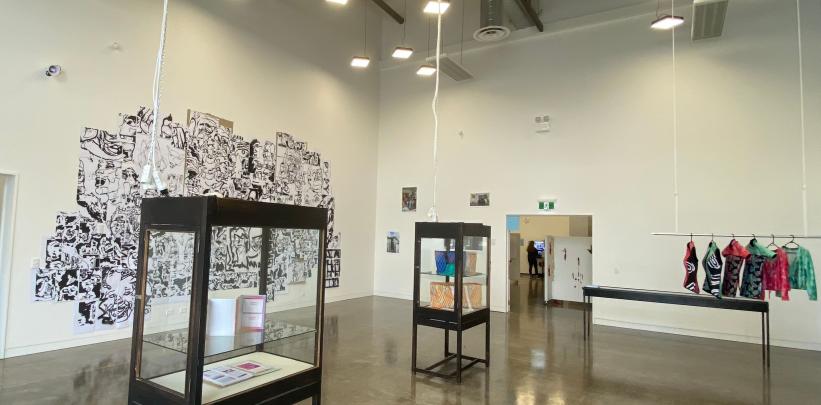Space To Create - New Facilities Lifting Student Possibilities
04 Dec 2023
Raising the standards has been taken to new heights at Unitec | Te Pūkenga - with students given additional avenues to shine and smash through their creative ceilings.
Space is more than the final frontier - it’s a commodity that can change a creative’s world.
Head of School for Unitec - Te Pūkenga’s Creative Industries programmes, Associate Professor Vanessa Byrnes knows full well the impact it can have.
“I’ve always thought it was a strange irony that in our profession, one of the few resources you need is space to work in - but it’s the most unaffordable thing to have in Auckland.
“In reality, you could fit a lot of people in here” she notes, “and arguably the current teacher-to-student ratio doesn’t really make sense.
“But in terms of social impact and those educational outcomes … for an institution to come up with such incredible space, it can really make a difference.”
And that’s exactly how it’s proven for the Tāmaki Makaurau-based tertiary institution, with its market-leading new facility and stunning gallery already reaping rewards for design and contemporary arts (DCA) students.
November’s DCA Gradshow launched with an exhibition of 21 students’ work in the impressive Building 108, located in the heart of Unitec’s sprawling Mt Albert campus and now home to the School of Creative Industries.
Reaching this special milestone has been a challenging journey for the budding artists and designers alongside the lecturers, teachers, leaders, technicians and administrators.
COVID, the cost of living crisis and a number of building moves tested patience and resilience levels before the Toi o Wairaka Gallery hosted its first exhibition supporting ākonga (students) and kaimahi (staff) in August.
Visually, the space is incredibly clean but warm - stretching through three high, white-walled rooms contrasted with a burnished earth-toned floor and highlighted by tastefully appointed spotlights and partitions that seamlessly showcase large expansive works.
It’s a fitting stage for artistic expressions that have been fine-tuned since the Bachelor of Design and Contemporary Art became a pathway to rewarding careers.
The foyer was crammed with proud students, whānau, friends, lecturers, staff, and senior officials to mark their considerable end-of-year accomplishments with a night of celebration, achievement and wondrous creations.
Byrnes strongly believes the facility will lead the way beyond educational training. “The great gift of this building” she explains, “is that we will to open these spaces up to the community - and that includes industry. Sooner or later, you need a circuit breaker in our sector and I think for us, this building is a game changer because it’s enveloping and giving mana to multiple practices including Screen, Art, and Design.
The graduates on show are quick to tautoko those views - relishing their limited time at a thoroughly modern built-for-purpose facility, which opened up in the final semester of their degree.
24-year-old Max Falkiner has crafted finely tuned angles and patterns into a striking design piece titled Emotional Interference Furniture that captured plenty of admirers in Toi o Wairaka.
“This semester (with the new facilities) is streets ahead of the old facilities. It’s such an improved learning environment here.
“I definitely wouldn’t have been able to even get close to the scale and quality of work with what we had on offer before this. And also the mode of all the teaching staff and students - it’s just been easier to be here, to be invested in our work.”
While Falkiner plans to head for Melbourne next year and set up his own practice, others have been bitten by the academic bug.
Alyssa Beckwith is a young woman inspired by her educational experience at Unitec - after creating three haunting, melting, saturated orange self-portraits from a series Slip acrylic and oil on canvas.
Her goal is to pursue a career in education - after being captivated by the artistic experience.
“It’s great - I have a space in the facility which I love. The light is great, the view .. and just like technically - it lets me carry on with my space without encroaching on others.”
Beckwith is certain the new facility will change the landscape for contemporary art students. “It’s going to be huge. It already has been huge, having this space - the openness compared to our old buildings, more about collaboration and relationship with your peers, the way we bounce ideas off each other.
“Everyone's mood is lifted here and I think that’s an important part of this process in getting a degree .. that’s how you grow, right?”
Erin Gosselman - whose spooky, otherworldly photographic images produced Phantasmagoria: Belly - found the new facility allowed her to finish her degree with a flourish after transferring from another institution.
“This space has really helped. I’m thinking of coming back and doing my masters .. when I take a gap year. I want to do teaching as well.”
West Aucklander Damen Dooms was another student to make full use of what he had to work with under the expert guidance of Academic Programme Manager Dr Bobby Hung and fellow leaders Dr Cris de Groot and Emma Smith. He commanded one of the gallery walls with three huge, captivating prints of young men showing intense natural emotions, having taken advantage of the dark room and advanced printing rooms on the first floor.
Byrnes adds part of what makes Building 108 stand out is its extensive array of such learning, practical, dedicated and technical spaces.
“We’ve got one of the few ceramics spaces locally in here … it’s extraordinary we’ve still got that and the photography dark room .. a lot of these ‘old school’ practical spaces have been jettisoned out of institutions. We are grateful to have them.”
Former cabinet minister Peseta Sam Lotu-Iiga is Te Pūkenga Executive Director Rohe 1 - which covers polytechnics, industry training organisations and institutes of technology in Auckland and Northland - and he sees a tangible return for the facility’s multi-million dollar outlay.
“For us, it’s an investment and it’s about people. We need a base for creative arts and the talents we have.
“We’ve got a shortage of these types of facilities. When you look over the last ten or so years .. we’ve seen a contraction in the offerings. We’re looking at our opportunities.”
Lotu-Iiga is also looking at competition with other tertiary organisations.
“Buildings are only one piece of it. This is part of a bigger, wider drive to educate, to do it in a way that actually reflects the community but also in a way that’s welcoming and warm.
“It’s the people, it’s the culture - certainly, my vision is that it should lead to that creative job.”
With the range of facilities and - importantly - the room to move and grow, Unitec is well-placed to be a leading choice for creatives throughout Tāmaki Makaurau and the northern region.


